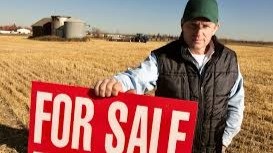December 31, 2024
In Canada, farmland ownership is undergoing significant changes, with increasing involvement from investment firms, pension funds, and wealthy individuals. This trend is particularly evident in the Prairie provinces, where large-scale acquisitions reshape the agricultural landscape.
One prominent figure is Robert Andjelic, an investor from Alberta who has become Canada's largest farmland owner, holding over 225,000 acres in Saskatchewan. His company leases this land to numerous farmers and often undertakes "land improvements," such as clearing natural habitats to maximize arable land.
Another significant player is Bonnefield, Canada's first and largest farmland investment corporation. Based in Toronto, Bonnefield manages over $1.4 billion in assets across seven provinces, encompassing approximately 140,000 acres. The company purchases farmland and leases it back to farmers, a model that has become increasingly common as land prices soar, making ownership challenging for individual farmers.
This shift towards investor ownership has raised concerns among farmers and rural communities. Many worry that the influx of investment capital drives up land prices, making it difficult for new and smaller-scale farmers to acquire land. Additionally, there are apprehensions about the environmental impact of large-scale farming practices often associated with investor-owned lands, such as the removal of natural habitats to increase cultivation areas.
While foreign ownership of Canadian farmland is a topic of discussion, domestic investors currently play a more substantial role in the market. The increasing financialization of farmland mirrors trends observed in urban real estate, where investment entities have significantly influenced market dynamics.
Overall, the growing involvement of investment firms and individuals in Canadian farmland is reshaping the agricultural sector, prompting debates about the future of farming, land accessibility, and the sustainability of rural communities.
The ownership of farmland in Canada is undergoing a seismic shift. Once dominated by families and small-scale farmers, this essential resource is increasingly concentrated in the hands of wealthy individuals and investment firms. This trend raises significant questions about the future of agriculture, rural communities, and food security in the country.
The Major Players
- Robert Andjelic Known as Canada’s largest private farmland owner, Robert Andjelic has acquired over 225,000 acres of farmland, predominantly in Saskatchewan. Starting his acquisitions in 2011, Andjelic has employed a strategy of buying high-quality farmland and leasing it back to farmers under long-term agreements. While this provides farmers with access to land without ownership burdens, it also means that control over the land shifts to one individual.
- Bonnefield Financial Bonnefield, Canada’s largest farmland investment firm, manages over 140,000 acres across seven provinces. Their model involves purchasing farmland and leasing it back to farmers, promoting “land stewardship” while prioritizing returns for their investors. With more than $1.4 billion in assets, Bonnefield’s influence extends far beyond individual farmers, shaping market dynamics across the country.
- Other Investment Firms and Pension Funds Entities such as pension funds and private equity firms have also entered the farmland market, driven by its stable returns and potential as a hedge against inflation. This trend mirrors the financialization of urban real estate, where investment capital has significantly impacted accessibility and affordability.
The Impact on Rural Communities and Farmers
- Rising Land Prices The influx of wealthy investors and institutions has driven up the cost of farmland, making it increasingly unattainable for small and new farmers. With the average price per acre in Canada increasing by 8.8% annually (according to Farm Credit Canada’s 2023 report), young farmers often face insurmountable barriers to entry.
- Shift in Land Stewardship Investor ownership prioritizes profit over traditional farming values, such as sustainable land use and community ties. In some cases, natural habitats are cleared to maximize cultivation, impacting biodiversity and the environment.
- Erosion of Local Control When farmland is owned by absentee landlords or corporations, decision-making moves away from the communities that depend on it. This can lead to reduced investment in local infrastructure and a decline in the sense of rural self-sufficiency.
Food Security Concerns
As control of farmland becomes concentrated, concerns about food sovereignty arise. Will decisions about what is grown and how it’s grown prioritize the needs of Canadians, or will they cater to global markets and investor interests? This shift has potential implications for the affordability and availability of domestically produced food.
Comparing Canada to the United States
The trend of farmland consolidation is not unique to Canada. In the United States, individuals like Bill Gates have become the largest farmland owners, raising similar concerns. Gates owns over 270,000 acres across multiple states. While Robert Andjelic’s holdings are smaller, they’re highly concentrated in Saskatchewan, amplifying his influence in one of Canada’s most agriculturally significant regions.
What Can Be Done?
- Regulating Farmland Ownership Several Canadian provinces, including Saskatchewan, have restrictions on foreign ownership of farmland. However, these regulations often fail to address domestic investors and corporations. Policymakers must explore broader measures to ensure farmland remains accessible to Canadian farmers.
- Support for Young Farmers Governments can provide subsidies, low-interest loans, or grants to help young farmers purchase land. Without intervention, the next generation of farmers may be locked out of the industry entirely.
- Environmental Protections To counter the environmental impact of large-scale farming practices, stricter regulations on land use and habitat preservation should be enforced.
- Transparency in Land Transactions Implementing a public registry of farmland transactions could help monitor ownership patterns and identify potential risks to food security and rural communities.
Conclusion
The increasing concentration of farmland ownership in Canada represents a profound shift with wide-ranging implications. While investors argue that their involvement brings efficiency and capital to the agricultural sector, the costs to rural communities, the environment, and food security cannot be ignored. Policymakers, farmers, and citizens must engage in this discussion and ensure that the future of Canadian farmland aligns with the nation’s broader interests rather than the portfolios of a select few.

No comments:
Post a Comment
Thanks for your thoughts, comments and opinions, will be in touch. Peter Clarke